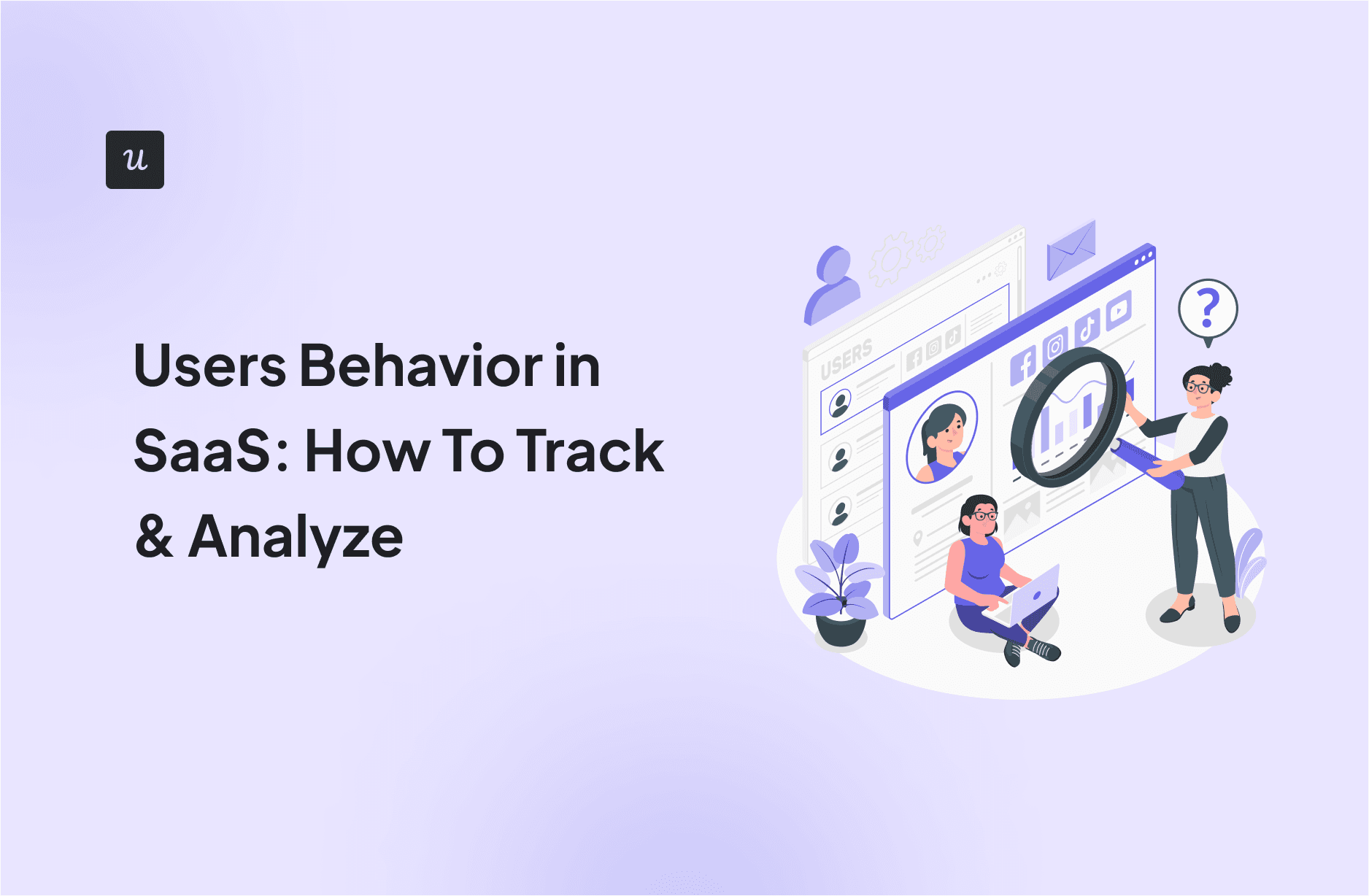
How can you analyze user behavior from behind the window of your screen?
Unlike physical stores, where you can observe how customers interact inside the shop, SaaS consumers are much more elusive. This is where user behavior analytics comes in.
It lets you track and analyze how users interact with your product so that you can offer superior customer experiences and achieve product growth.
So let’s dive in!
Try Userpilot Now
See Why 1,000+ Teams Choose Userpilot

What is user behavior?
User behavior refers to all the actions and patterns users exhibit when interacting with your product. These activities include what pages they visit, what they click on, where they get stuck, and where they leave your site.
Thus, tracking and analyzing user behavior allows you to find areas of improvement and enhance in-app experiences to provide the highest value to customers.
Why is understanding user behavior important for SaaS companies?
Just collecting user behavior data isn’t enough. You need to analyze them to generate valuable insights that you can use to craft different business strategies.
Now let’s see why you need to track your SaaS and understand your users’ behavior.
- User behavior analytics helps you gain a deep understanding of your customers’ in-app behavior and their needs. Analyzing the trends and patterns in their behavior allows you to optimize the customer experience.
- Tracking user behavior can help you create hyper-personalized marketing campaigns and in-app messages for specific user segments. This will drive more value for users and thus, increase customer engagement and retention.
- Behavior analytics looks at the different stages of the customer journey and the various communication channels you use with customers. You can identify friction points and remove them so that users don’t get frustrated with too many obstacles inside your product.
Key user behavior metrics to measure users’ behavior
Here are 12 metrics you can use to measure your customer behavior. Note that none of these behavioral metrics overlap with marketing metrics since the latter focus more on converting to paying customers.
- Activation rate: This is the rate at which new users complete the first key actions inside your product and reach the activation point. It measures the success of your primary onboarding efforts.
- Stickiness ratio: the proportion of customers who are returning to your product or a particular feature on a regular basis. It’s equal to the ratio of the number of daily active users to the number of monthly active users.
- Feature usage: A low feature usage means either your customers are not getting value from the feature or they’re not aware of it in the first place. Thus, knowing this usage rate can help you determine what features to add, improve, or remove.

- Funnel drop-off during activation: This metric gives you a clear picture of new users leaving your product before converting to paying customers.

- Adoption rate: This is the percentage of individuals who convert from prospects to users.
- Sessions per user: This measures the number of times a customer uses your product. Thus, it can also act as one of the indicators of engagement.
- Retention rate: It measures the percentage of customers who choose to keep investing in your product. This is also an important indicator alongside other retention metrics like customer lifetime value.

- Customer churn rate: This is the percentage of customers who abandon your product during a specific period. There will always be customers who churn, but you need to minimize this rate to retain as many customers as possible.
- Monthly Recurring Revenue (MRR): It’s the monthly revenue you earn from your subscriptions to your product. The greater your retention, the higher your MRR.
- Annual Recurring Revenue (ARR): It’s the total amount you earn from subscriptions in a year.
How to collect user behavior data
How can you collect data for tracking user behavior? Here are 4 ways you can do that.
Track feature usage and in-product interactions
Not all customers will benefit from a particular feature. This makes it all the more important to monitor what customers are doing inside the app and understand their interactions with different features.
Userpilot offers the feature tagging functionality without any coding. You can tag any UI element to track feature usage among various customer segments across the user journey.
It allows you to not only tag features, but also track clicks, hovers, and text inputs to collect user data from different interactions.
With a tracking system in place, you can identify the features that are the most used and analyze user behavior to know what drives feature adoption.

Use custom events to track how users interact
Unlike predefined events (such as page views or clicks), custom events allow you to capture user interactions that are unique to your product i.e. how users convert from signing up.
As you’ve identified the custom events to track, implement tracking code within your product to capture these events.
For example, in Userpilot, you can start tracking custom events by copying the script to track events in your web app and sharing it with your dev team. Once the event is passed, you can find all the analytics in the overview tab and group them to even track an entire process.

Send microsurveys to collect feedback and measure user sentiment
User behavior insights are incomplete unless you collect feedback directly from your customers. Send microsurveys at different stages of the user journey and gather feedback to understand user sentiment about your product.
There are several kinds of microsurveys, such as the Net Promoter Score (NPS) survey, Customer Satisfaction (CSAT) survey, Customer Effort Score (CES) survey, and more.
We recommend you add a follow-up question to these surveys to get qualitative data on user behavior. These questions are open-ended, thus allowing customers to explain why they gave a particular score.
Userpilot lets you build these surveys code-free and analyze the user feedback to understand customer pain points and improve your product and customer experience accordingly.

How to analyze user behavior data
Now let’s see how you can analyze user behavior.
Visualize behavior analytics data to identify trends and patterns
Using a behavior analytics tool, you can create visual representations of your user behavior data, such as charts, graphs, and dashboards.
Visualizations make it easier to spot correlations, anomalies, and changes in user behavior over time.
One of the user behavior analytics examples using visualization is comparing user behavior before and after implementing engagement strategies.
By comparing feature usage trends over time, you can assess the effectiveness of your engagement initiatives and identify any changes in user behavior resulting from these efforts.

Break down behavioral data into individual levels for granular insights
This approach lets you understand how individual users and companies engage with your product, enabling you to effectively tailor experiences and offerings.
For example, Userpilot offers a feature called “Profiles,” which provides enhanced visualization of user and company data.
With Profiles, you can view detailed information about individual users and organizations that are using your product. This includes data such as user activity, feature usage, engagement metrics, and more.
You can then determine how frequently they use certain features, which features they find most valuable, and where they encounter challenges or friction points.

Segment customers into behavioral cohorts
You should segment users based on their behavior and group them into cohorts. Analyze the data generated from each cohort to identify trends in behavior and why some cohorts are more engaged than others.
You can then use the insights to offer personalized onboarding flows to each cohort to drive user engagement.
Moreover, segmentation helps you identify your power users and analyze their behavior to learn more about your product’s strong points and how you can replicate that for other, less-engaged customer segments.
Userpilot lets you segment customers based on user, company data, user feedback, feature and events usage, and content engagement.

Use funnel analysis to understand where users encounter friction
Funnel analysis is a method to analyze user behavior data by visualizing the sequential steps users take within a defined conversion or engagement process.
You can start by defining the series of steps that users need to complete to achieve a specific goal. Then use a tracking tool to capture data on user actions, events, or behaviors and monitor user progress through each step of the funnel.

With funnel charts, you can easily identify areas where users encounter friction that prevents them from progressing to the next step.
Conduct path analysis to see how users advance in their journey
Path analysis allows you to dissect the sequence of steps or actions users undertake as they traverse your product.
By harnessing insights gleaned from this analysis, you can polish your customer journey map, thereby steering users towards targeted actions, such as conversions.
For instance, you can utilize path analysis to scrutinize how users progress after signing up. Do they engage with onboarding guidance? What is the most common path to activation?

This scrutiny provides actionable insights into the user journey users undertake and therefore you can refine onboarding strategies accordingly.
Analyze user behavior through feedback
With insights through surveys, especially qualitative data from follow-up questions, you can identify common issues happening with your product.
You should look for recurring issues, suggestions for improvement, and positive feedback on features or aspects of the product that users appreciate.
For example, you can use response tags in Userpilot to group and find improvement opportunities.

Best tools to track user behavior in depth
Behavior analytics software consists of sophisticated algorithms and tools designed to track, analyze, and interpret user behavior. Therefore, with an analytics tool, collecting and analyzing user data will be so much easier.
So, let’s look at some of the best behavior analytics tools out there.
Userpilot – for tracking in-product usage and collecting feedback
Userpilot is a product growth platform. It lets you monitor in-app behavior with no-code feature tags and event-tracking scripts.

You can also use its powerful microsurvey functionality. Be it NPS, CES, CSAT, or other kinds of microsurveys, you can create them all using Userpilot and get actionable insights by analyzing the data.

It also comes with powerful analytics features such as funnels, paths, retention tables, etc., and built-in dashboards to help you keep track of key product metrics.

Amplitude – for user behavior analytics
Amplitude is a product analytics tool that is great for mapping customer journeys.
Its path chart shows how customers navigate defined paths within your product’s funnel. The in-product analytics allows on-site tracking in real time.
Amplitude’s free plan lets you track 10 million events per month and provides unlimited user seats. It hasn’t publicly disclosed the prices for the paid subscription plans.

Hotjar – for session recordings and heat maps
Hotjar is great for visualizing user behavior through session recordings and heat maps.
The heat maps let you record users’ behavior on a selected URL, like hovers, mouse movements, scrolls, and taps.
Hotjar offers a forever free plan with up to 1,050 sessions per month. Its basic or Plus plan starts at $32/month.

Conclusion
Customers form the biggest asset of your company. Thus, user behavior analysis is a must to develop effective strategies and provide a competitive customer experience.
Want to start analyzing your users’ behavior and collect invaluable insights code-free? Get a Userpilot demo and see how you can do it.








